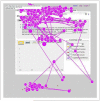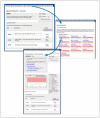Development and usability testing of a web-based cancer symptom and quality-of-life support intervention
- PMID: 24406906
- PMCID: PMC4747103
- DOI: 10.1177/1460458213495744
Development and usability testing of a web-based cancer symptom and quality-of-life support intervention
Abstract
The feasibility and acceptability of computerized screening and patient-reported outcome measures have been demonstrated in the literature. However, patient-centered management of health information entails two challenges: gathering and presenting data using "patient-tailored" methods and supporting "patient-control" of health information. The design and development of many symptom and quality-of-life information systems have not included opportunities for systematically collecting and analyzing user input. As part of a larger clinical trial, the Electronic Self-Report Assessment for Cancer-II project, participatory design approaches were used to build and test new features and interfaces for patient/caregiver users. The research questions centered on patient/caregiver preferences with regard to the following: (a) content, (b) user interface needs, (c) patient-oriented summary, and (d) patient-controlled sharing of information with family, caregivers, and clinicians. Mixed methods were used with an emphasis on qualitative approaches; focus groups and individual usability tests were the primary research methods. Focus group data were content analyzed, while individual usability sessions were assessed with both qualitative and quantitative methods. We identified 12 key patient/caregiver preferences through focus groups with 6 participants. We implemented seven of these preferences during the iterative design process. We deferred development for some of the preferences due to resource constraints. During individual usability testing (n = 8), we were able to identify 65 usability issues ranging from minor user confusion to critical errors that blocked task completion. The participatory development model that we used led to features and design revisions that were patient centered. We are currently evaluating new approaches for the application interface and for future research pathways. We encourage other researchers to adopt user-centered design approaches when building patient-centered technologies.
Keywords: IT design and development methodologies; consumer health information; decision-support systems; ehealth; evidence-based practice.
© The Author(s) 2014.
Figures
Similar articles
-
Development of an integrated e-health tool for people with, or at high risk of, cardiovascular disease: The Consumer Navigation of Electronic Cardiovascular Tools (CONNECT) web application.Int J Med Inform. 2016 Dec;96:24-37. doi: 10.1016/j.ijmedinf.2016.01.009. Epub 2016 Jan 24. Int J Med Inform. 2016. PMID: 26847070
-
The future of Cochrane Neonatal.Early Hum Dev. 2020 Nov;150:105191. doi: 10.1016/j.earlhumdev.2020.105191. Epub 2020 Sep 12. Early Hum Dev. 2020. PMID: 33036834
-
Usability testing of an online self-management program for adolescents with juvenile idiopathic arthritis.J Med Internet Res. 2010 Jul 29;12(3):e30. doi: 10.2196/jmir.1349. J Med Internet Res. 2010. PMID: 20675293 Free PMC article.
-
Implementation of a user-centered framework in the development of a web-based health information database and call center.J Biomed Inform. 2011 Oct;44(5):897-908. doi: 10.1016/j.jbi.2011.03.001. Epub 2011 Mar 17. J Biomed Inform. 2011. PMID: 21396486 Review.
-
Rapid systematic review on developing web-based interventions to support people affected by cancer.BMJ Open. 2022 Sep 6;12(9):e062026. doi: 10.1136/bmjopen-2022-062026. BMJ Open. 2022. PMID: 36691118 Free PMC article.
Cited by
-
Exposure to a patient-centered, Web-based intervention for managing cancer symptom and quality of life issues: impact on symptom distress.J Med Internet Res. 2015 Jun 3;17(6):e136. doi: 10.2196/jmir.4190. J Med Internet Res. 2015. PMID: 26041682 Free PMC article. Clinical Trial.
-
A Randomized Controlled Trial Protocol to Evaluate the Effectiveness of an Integrated Care Management Approach to Improve Adherence Among HIV-Infected Patients in Routine Clinical Care: Rationale and Design.JMIR Res Protoc. 2016 Oct 5;5(4):e156. doi: 10.2196/resprot.5492. JMIR Res Protoc. 2016. PMID: 27707688 Free PMC article.
-
Development of an Internet Intervention to Address Behaviors Associated with Skin Cancer Risk among Young Adults.Internet Interv. 2015 Sep;2(3):340-350. doi: 10.1016/j.invent.2015.04.003. Epub 2015 May 6. Internet Interv. 2015. PMID: 26640776 Free PMC article.
-
Development of an eHealth tool for cancer patients: monitoring psycho-emotional aspects with the Family Resilience (FaRe) Questionnaire.Ecancermedicalscience. 2018 Jul 11;12:852. doi: 10.3332/ecancer.2018.852. eCollection 2018. Ecancermedicalscience. 2018. PMID: 30079114 Free PMC article. Review.
-
The Importance of Systematically Reporting and Reflecting on eHealth Development: Participatory Development Process of a Virtual Reality Application for Forensic Mental Health Care.J Med Internet Res. 2019 Aug 19;21(8):e12972. doi: 10.2196/12972. J Med Internet Res. 2019. PMID: 31429415 Free PMC article.
References
-
- Berry D, Trigg L, Lober W, et al. Computerized symptom and quality-of-life assessment for patients with cancer part I: development and pilot testing. Oncol Nurs Forum. 2004;31(5):E75–E83. - PubMed
-
- Slack W, Hicks P, Reed C, et al. A computer-based medical history system. N Engl J Med. 1966;274(4):194–198. - PubMed
-
- Velikova G, Wright EP, Smith AB, et al. Automated collection of quality-of-life data: a comparison of paper and computer touch-screen questionnaires. J Clin Oncol. 1999;17(3):998–1007. - PubMed
Publication types
MeSH terms
Grants and funding
LinkOut - more resources
Full Text Sources
Other Literature Sources
Research Materials






